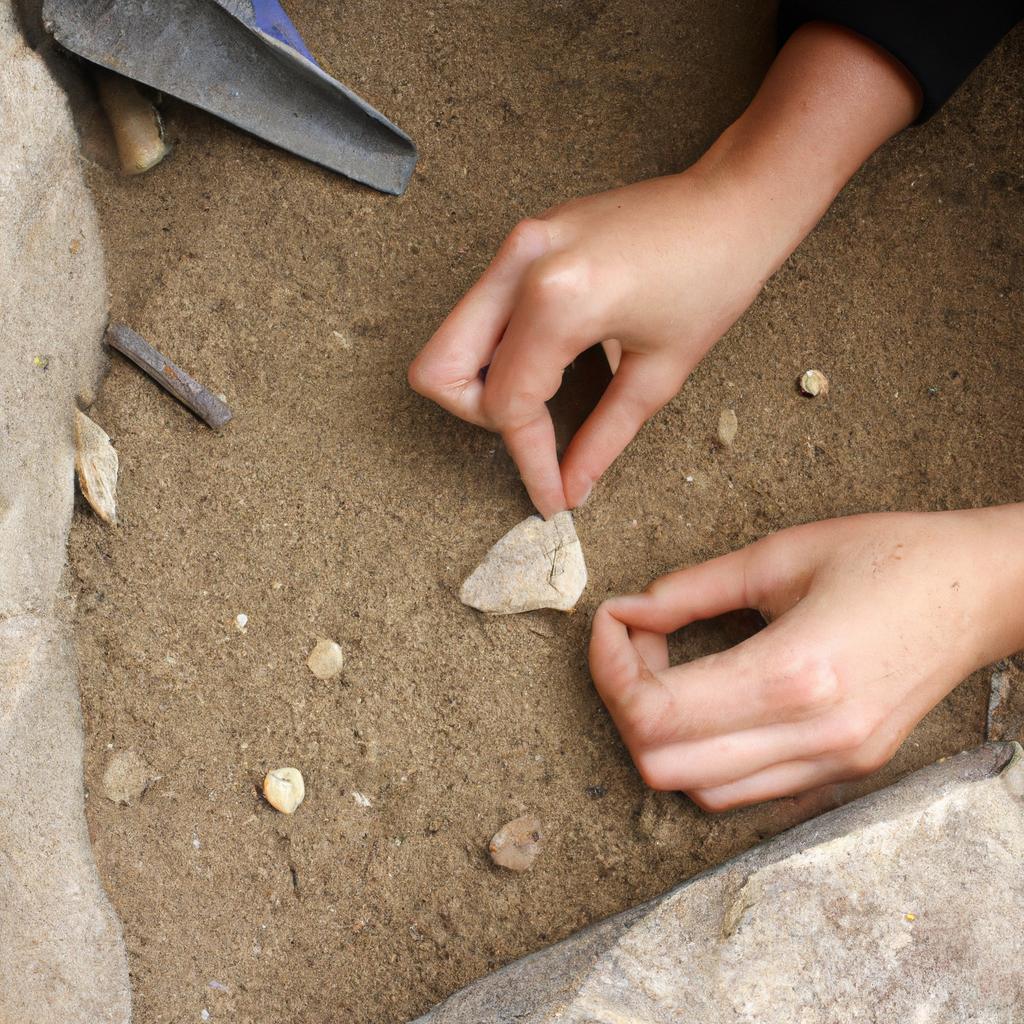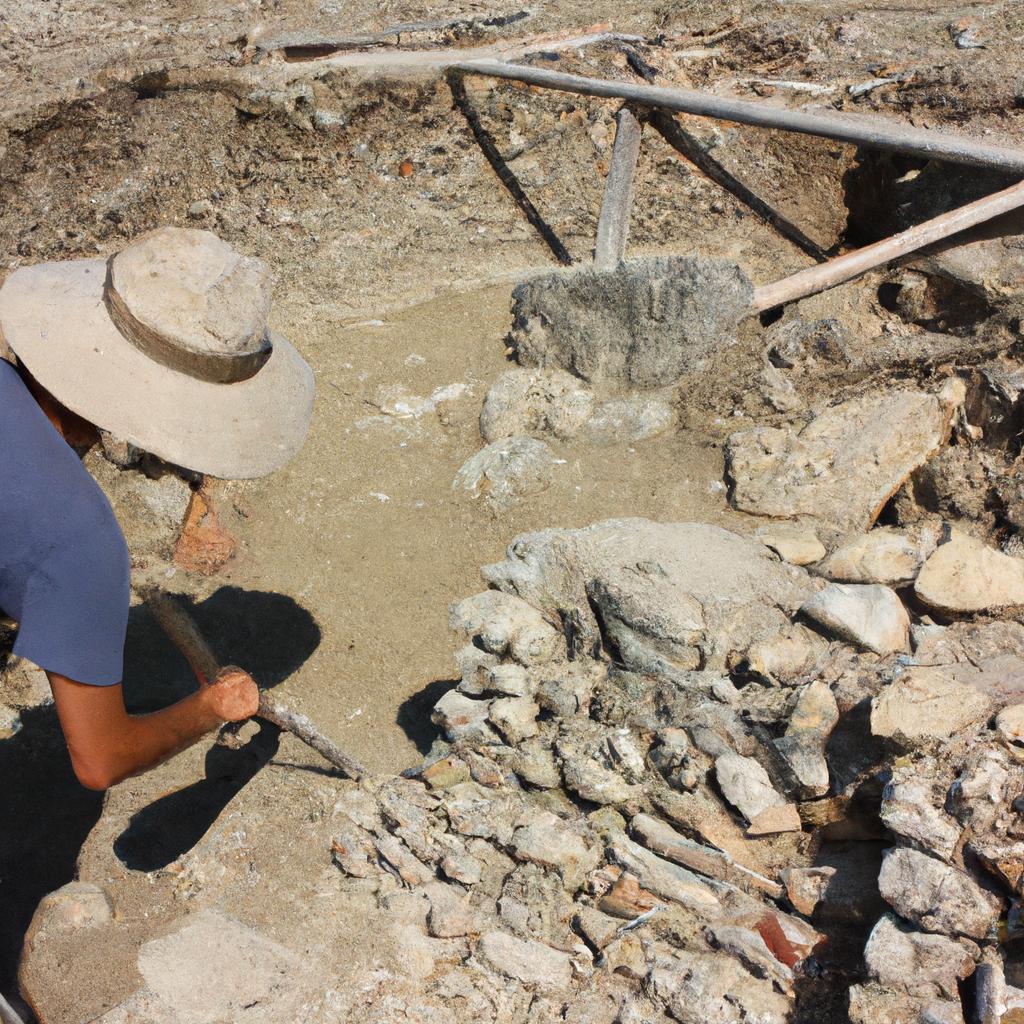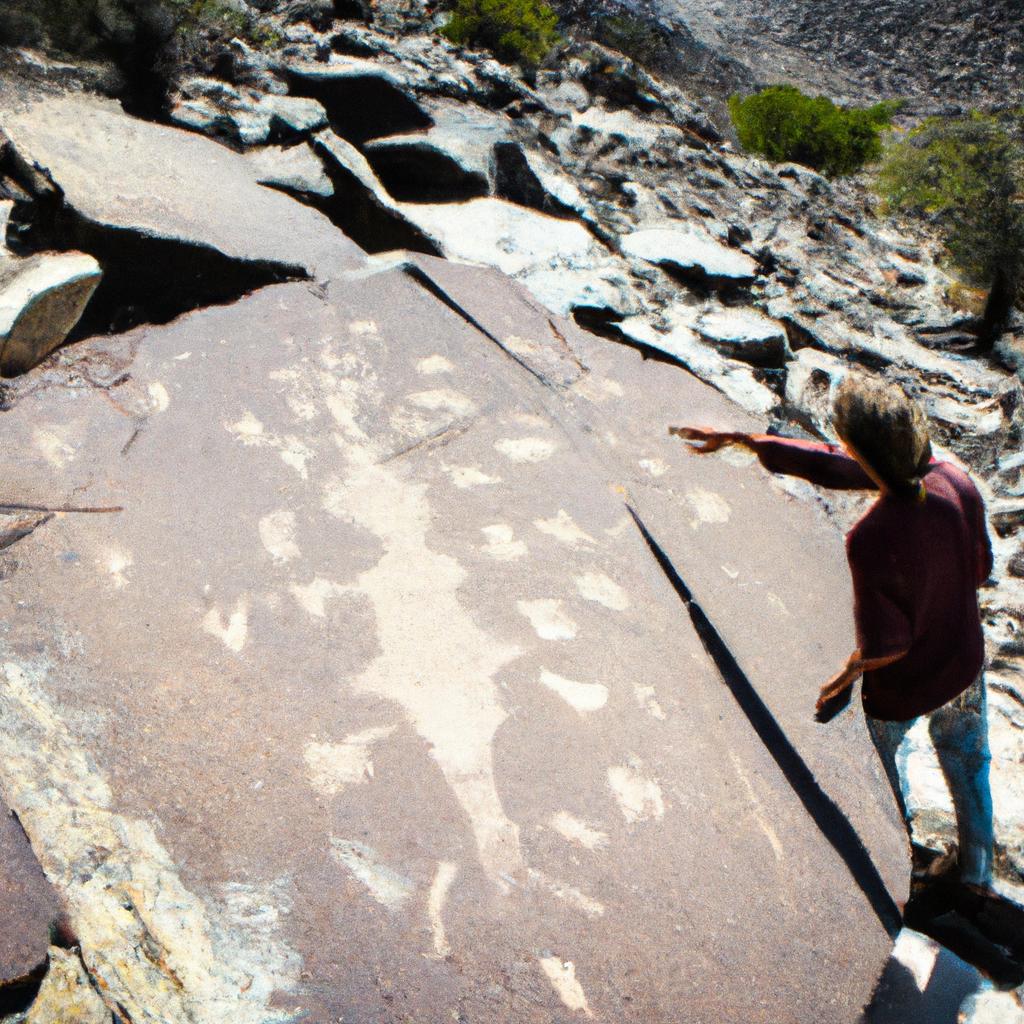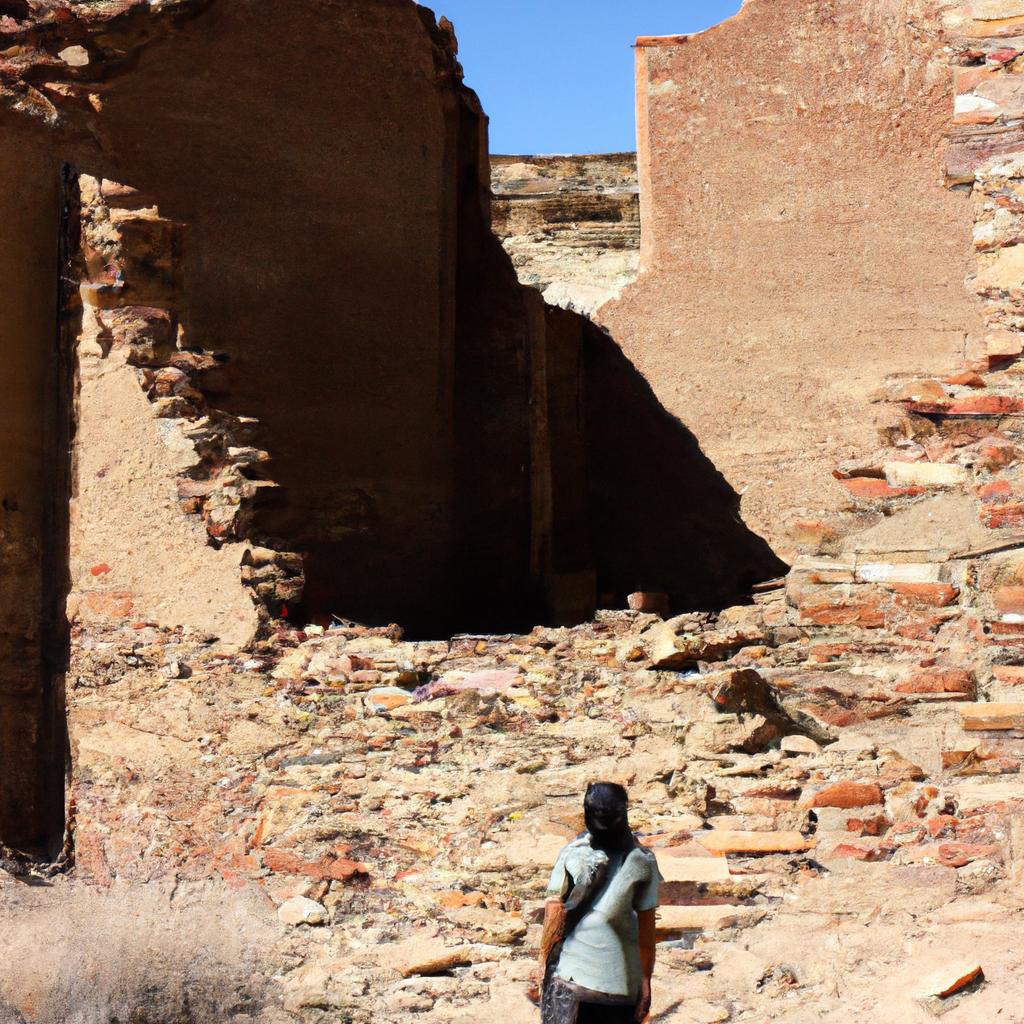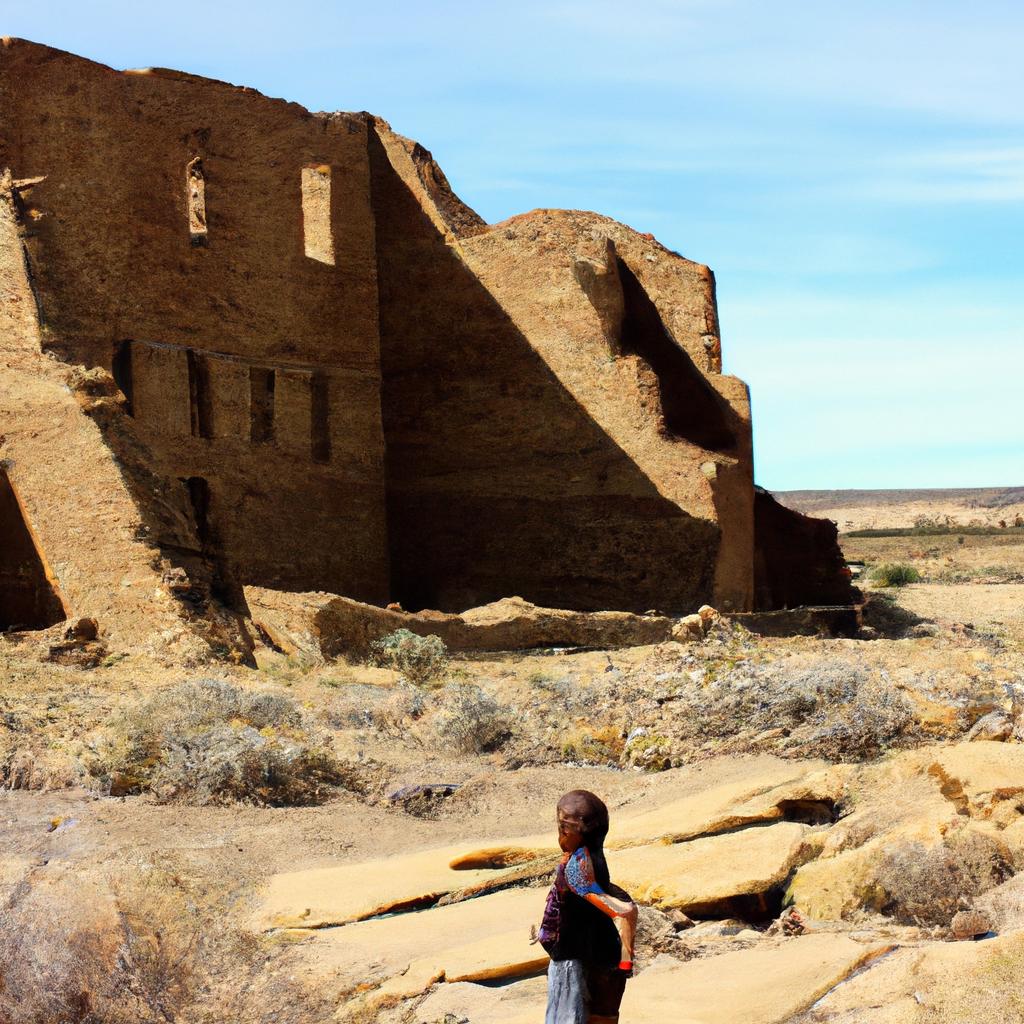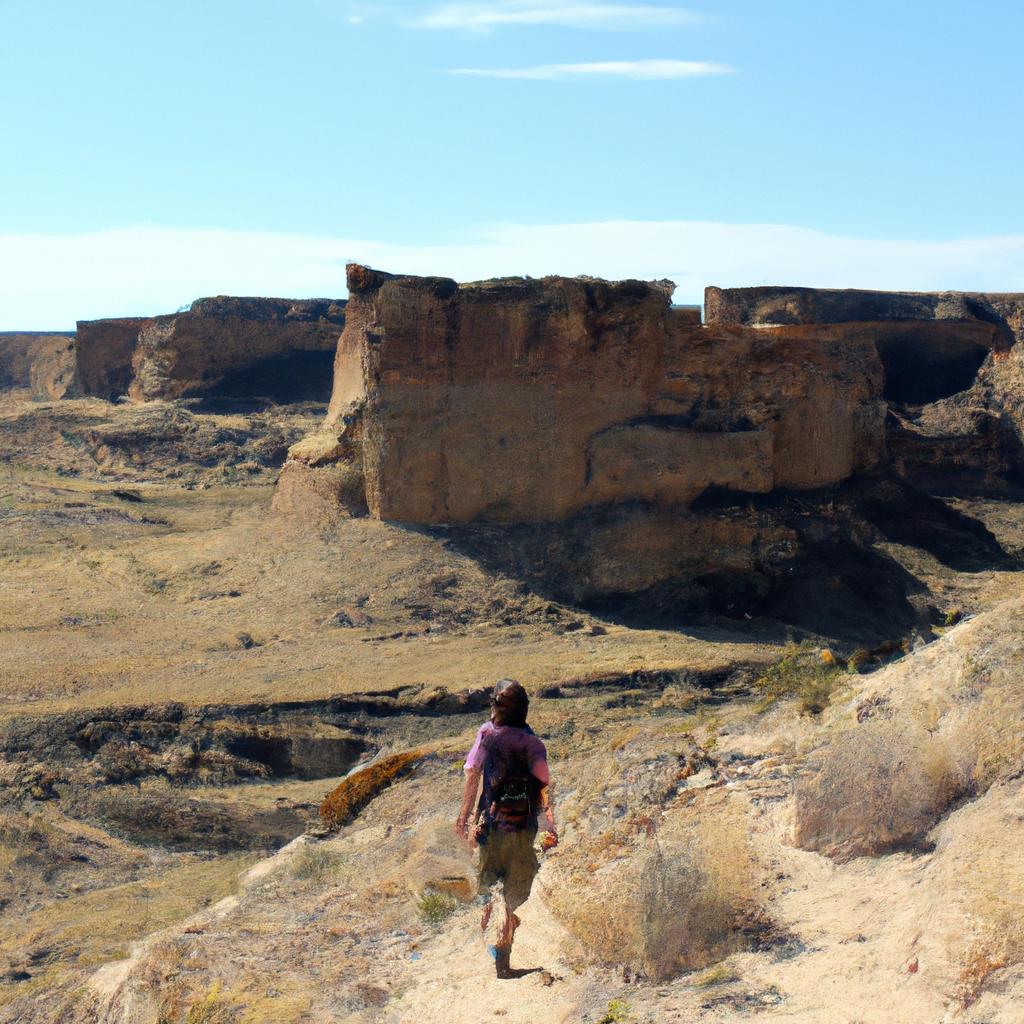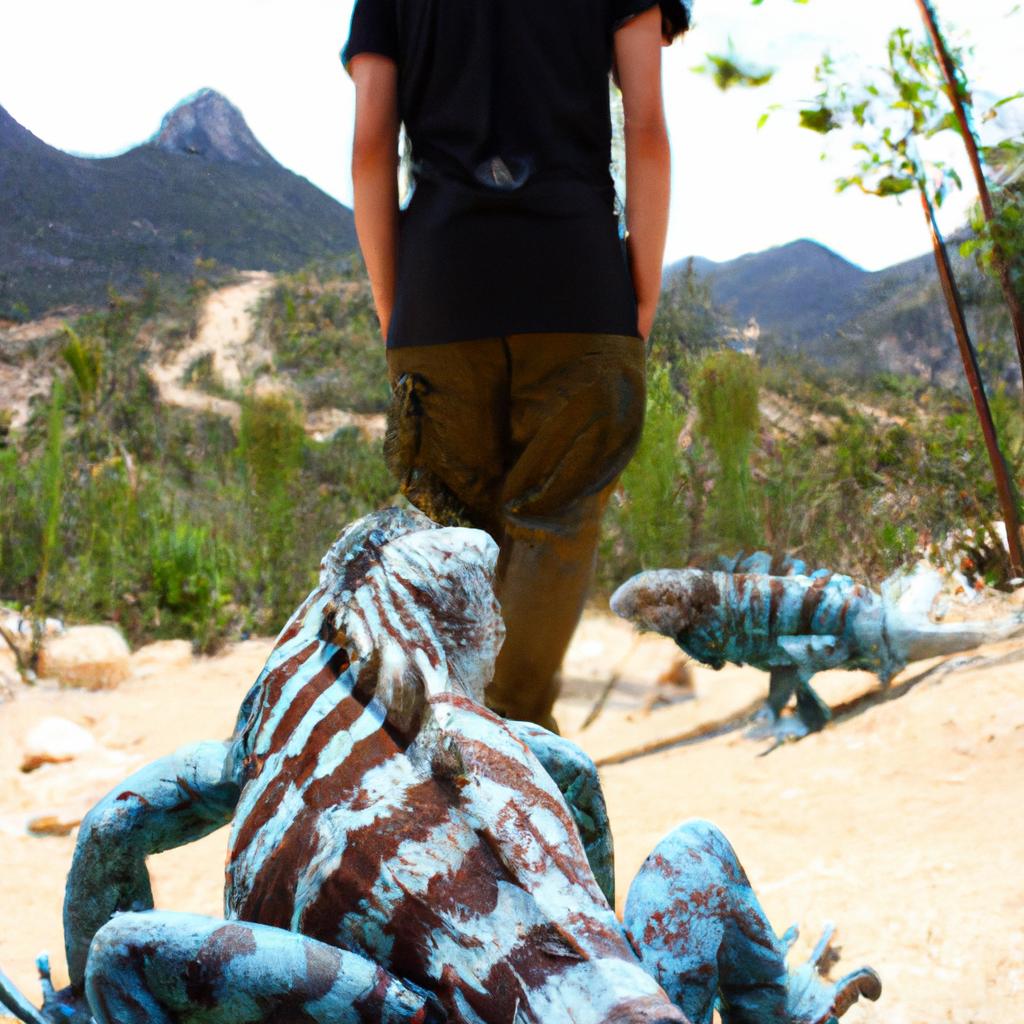Chaco Canyon, located in the southwestern region of present-day New Mexico, is a site of immense archaeological significance. Its rich cultural heritage and well-preserved ruins have captivated researchers for decades. One compelling example that exemplifies the importance of Chaco Canyon’s archaeology is the discovery of Una Vida, an ancient Great House complex within the canyon. This article aims to delve into the historical context, architectural features, and anthropological implications of Una Vida, shedding light on its role as a key component in understanding the complexity of Chacoan society.
The study of Una Vida provides valuable insights into the societal organization and religious practices prevalent during the era when Chaco Canyon flourished. By examining this remarkable structure and analyzing its unique characteristics, scholars can gain a deeper understanding of how early societies functioned both socially and politically. Additionally, exploring Una Vida enables us to unravel the intricate network of trade routes that connected various regions across pre-Columbian North America. Through meticulous excavation efforts and comprehensive studies conducted at Una Vida, archaeologists have been able to construct a more nuanced narrative surrounding Chacoan civilization and its interactions with neighboring communities.
This article will not only explore the architectural intricacies of Una Vida but also highlight its relevance to understanding the religious and ceremonial practices of Chacoan society. The layout and design of Una Vida, with its large central plaza and surrounding rooms, suggest a communal space used for gatherings and rituals. The presence of kivas, underground chambers associated with ceremonial activities, further supports this interpretation.
Moreover, the discovery of various artifacts within Una Vida has provided valuable insights into the religious beliefs and symbolism of the Chacoans. Intricately carved stone tablets depicting celestial bodies, intricate pottery designs, and sacred objects have been unearthed at the site. These findings shed light on the cosmological worldview and spiritual practices of the ancient inhabitants of Chaco Canyon.
In addition to its cultural significance, Una Vida’s architectural features offer valuable clues about the construction techniques employed by the Chacoans. The use of locally sourced sandstone blocks in combination with carefully crafted masonry demonstrates advanced architectural knowledge and engineering skills. The precise alignment of walls with astronomical phenomena also suggests an astute understanding of celestial movements.
Furthermore, Una Vida’s strategic location within Chaco Canyon highlights its role as a regional center for trade and exchange. Excavations have revealed evidence of exotic goods such as seashells from distant coastal regions and macaw feathers from tropical areas. This indicates that Chaco Canyon was not an isolated community but rather a hub for long-distance trade networks spanning across vast distances.
In conclusion, the study of Una Vida offers invaluable insights into the complexity of Chacoan society, including its social organization, religious practices, architectural expertise, and extensive trade connections. By examining this ancient Great House complex within Chaco Canyon, researchers can piece together a more comprehensive understanding of pre-Columbian North America’s fascinating history.
The History of Chaco Canyon
Chaco Canyon, located in the southwestern United States, is an archaeological site that has captivated researchers and visitors alike for centuries. Its rich history dates back to ancient times and offers a glimpse into the lives of the Ancestral Puebloans who once inhabited this region.
To illustrate the significance of Chaco Canyon’s history, let us consider an example: Imagine stumbling upon an abandoned village nestled deep within a canyon. As you explore its ruins, you begin to uncover remnants of a thriving civilization – intricate pottery shards, meticulously crafted tools, and well-preserved architectural structures. This hypothetical scenario mirrors the experiences of archaeologists who have excavated the sites at Chaco Canyon.
The exploration of Chaco Canyon’s past begins with understanding its timeline. The area was first settled around 850 AD and experienced significant growth throughout the following centuries. By analyzing artifacts found on-site along with radiocarbon dating techniques, experts have been able to piece together a comprehensive chronology spanning hundreds of years.
During its peak between 1030-1130 AD, Chaco Canyon served as a hub for trade networks stretching across vast distances—an impressive feat considering the limited technology available during that era. Traders exchanged valuable goods such as turquoise, macaws from Mexico, seashells from California coastlines, and cacao beans from Mesoamerica. This evidence suggests that Chacoan society had established complex economic relationships beyond their immediate surroundings.
It is important to note that while Chaco Canyon thrived economically and culturally, it eventually declined for reasons still debated by scholars today. Factors such as environmental changes—such as droughts—and social unrest may have contributed to its downfall. Despite these challenges, however, Chaco Canyon remains a testament to human resilience and ingenuity.
In light of its historical importance and archaeological richness, exploring the ruins at Chaco Canyon provides not only insight into past civilizations but also a chance to appreciate the resilience and complexity of human societies. The next section will delve into the significance of Chaco Canyon’s ruins, shedding light on their enduring impact.
[Table: Emotional Impact of Chaco Canyon]
| Emotion | Description | Example |
|---|---|---|
| Awe | Overwhelming sense of wonder and admiration | Standing in front of an intricate ceremonial kiva |
| Intrigue | Curiosity sparked by mysteries surrounding ancient civilizations | Deciphering petroglyphs etched onto canyon walls |
| Connection | Feeling linked to the past through shared human experiences | Imagining daily life within well-preserved dwellings |
| Contemplation | Reflection on the passage of time and the impermanence of civilizations | Observing crumbling structures once full of vitality |
With a deeper understanding of Chaco Canyon’s history, it becomes evident that this archaeological site holds immense value for both researchers and visitors alike. The following section will explore the significance behind its ruins, shedding light on how they continue to captivate our collective imagination.
The Significance of Chaco Canyon’s Ruins
Section Transition:
Having explored the rich history of Chaco Canyon, we now turn our attention to the significance of its ruins. To illustrate this, let us consider a hypothetical scenario where an archaeologist discovers a hidden chamber within one of the canyon’s ancient structures, revealing intricate murals depicting daily life and spiritual rituals.
Significance of Chaco Canyon’s Ruins
This newfound discovery serves as a testament to the enduring legacy left behind by the Ancestral Puebloans who once inhabited Chaco Canyon. It provides valuable insights into their beliefs, practices, and societal organization. By studying these murals, researchers can gain a deeper understanding of how spirituality was intertwined with everyday existence in this ancient civilization.
To further appreciate the importance of Chaco Canyon’s ruins, it is essential to highlight some key aspects:
-
Architectural Marvels:
- Great Houses such as Pueblo Bonito and Una Vida showcase remarkable engineering feats.
- Massive stone walls that rise several stories high reflect meticulous craftsmanship.
- Intricate masonry techniques demonstrate advanced architectural knowledge.
-
Trading Hub:
- The extensive road network connecting distant regions demonstrates Chaco Canyon’s role as
a central trading hub. - Exotic goods from various locations indicate long-distance trade connections.
- The presence of foreign artifacts suggests cultural exchange between different communities.
- The extensive road network connecting distant regions demonstrates Chaco Canyon’s role as
-
Astronomical Alignment:
- Specific alignments and orientations of buildings reveal astronomical knowledge possessed by
the Ancestral Puebloans. - Structures like Casa Rinconada were likely used for celestial observations or ceremonial purposes,
showcasing their deep connection with the cosmos.
- Specific alignments and orientations of buildings reveal astronomical knowledge possessed by
-
Social Complexity:
- The scale and grandeur of these ruins indicate a society with complex social hierarchies.
- The size and layout of the Great Houses suggest centralized control over resources and labor.
- Evidence of communal spaces implies communal gatherings and rituals.
In light of these aspects, it becomes clear that Chaco Canyon’s ruins hold immense value for understanding ancient civilizations. They provide glimpses into their architectural prowess, trade networks, astronomical knowledge, and social complexity – all contributing to our broader understanding of human history.
As we delve further into Chaco Canyon’s mysteries, we now turn our attention to the enigma surrounding its most iconic structures – the Great Houses. What secrets do they hold about the past? Let us explore ‘The Mystery of Chaco Canyon’s Great Houses’ in the next section.
The Mystery of Chaco Canyon’s Great Houses
Title: Una Vida: Chaco Canyon’s Archaeology
Previous section H2: The Significance of Chaco Canyon’s Ruins
Transition from Previous Section
Having explored the profound significance of Chaco Canyon’s ruins, we now turn our attention to another intriguing aspect that shrouds this ancient site – the mystery surrounding its great houses. By delving into one particular case study, we can uncover some fascinating insights into the enigmatic nature of these structures and their role within the wider archaeological context.
The Mystery of Chaco Canyon’s Great Houses
A striking example that epitomizes the perplexity surrounding Chaco Canyon’s great houses is Una Vida. Located in close proximity to Pueblo Bonito, this remarkable structure stands as an embodiment of architectural ingenuity. With over 150 rooms spread across three stories, it captivates both archaeologists and visitors alike. However, despite extensive investigation, scholars still grapple with fundamental questions about its purpose and use.
To fully comprehend the enigma presented by these great houses, let us explore a few key factors that contribute to their mysterious allure:
- Intricate Construction Techniques: The construction methods employed by ancestral Puebloans at Chaco Canyon were remarkably advanced for their time. Utilizing natural materials such as sandstone blocks and wooden beams transported over considerable distances, they orchestrated elaborate masonry feats in order to create awe-inspiring structures like Una Vida.
- Complex Social Organization: The sheer scale and intricacy of these great houses suggest a highly organized society capable of mobilizing significant labor forces. Deliberate planning went into every aspect – from room layout to communal spaces – indicating a social structure far more complex than previously imagined.
- Symbolic Significance: Beyond their functional aspects, great houses like Una Vida may have held deep symbolic meaning for the ancestral Puebloan people. Their monumental scale and grandeur could have been a reflection of the society’s religious or political ideologies, acting as focal points for communal rituals and gatherings.
- Integration with Landscape: Chaco Canyon is known for its remarkable alignment with celestial events. The positioning of great houses within this landscape further emphasizes their potential connection to astronomical observations. Some researchers propose that these structures were deliberately situated in relation to solstices or equinoxes, suggesting an intricate knowledge of celestial movements.
To better visualize the mystery surrounding Una Vida and other great houses at Chaco Canyon, consider the following table:
| Factors | Description |
|---|---|
| Construction | Utilized advanced techniques and transported materials |
| Social Hierarchy | Reflects complex social organization |
| Symbolism | May hold deep symbolic meaning |
| Astronomical Alignment | Connection to celestial events |
Understanding the various elements discussed above allows us to appreciate the enigmatic nature of Chaco Canyon’s great houses. By unraveling their secrets, we gain valuable insights into not only ancestral Puebloan culture but also the broader archaeological significance of this extraordinary site.
Transition to Next Section
As we delve deeper into our exploration of Chaco Canyon, it becomes evident that understanding its architectural marvels is incomplete without considering another vital aspect – the importance of its astronomical alignments.
The Importance of Chaco Canyon’s Astronomical Alignments
The Mystery of Chaco Canyon’s Great Houses has captivated archaeologists and historians for decades. As we delve deeper into the archaeological wonders of this ancient site, another intriguing aspect emerges: the importance of Chaco Canyon’s astronomical alignments. These celestial connections shed light on the advanced knowledge and cultural significance that these ancient inhabitants held towards celestial bodies.
To illustrate the profound connection between Chacoan architecture and astronomy, let us consider a hypothetical example. Imagine standing in front of Pueblo Bonito, one of the largest great houses in Chaco Canyon. As you gaze upon its massive walls and intricate construction, it becomes apparent that every detail was meticulously planned to align with celestial events. The structure’s east-west axis precisely captures the sunrise during both equinoxes, while certain windows frame specific phases of the moon throughout the year.
This deliberate alignment with celestial phenomena suggests several key points about Chacoan culture:
- Deep Spiritual Connection: By aligning their structures with celestial events, it is evident that the ancient inhabitants viewed these occurrences as sacred and essential aspects of their spiritual beliefs.
- Advanced Astronomical Knowledge: Constructing buildings with such precision requires an understanding of complex astronomical calculations. This indicates a sophisticated grasp of celestial movements and cycles.
- Organized Societal Structure: Coordinating large-scale architectural projects like those seen at Chaco Canyon would have required significant societal organization and collaboration.
- Shared Cultural Practices: The widespread incorporation of astronomical alignments across different great houses implies a cohesive cultural system among various communities within Chaco Canyon.
To further comprehend the magnitude of this relationship between architecture and astronomy, let us turn our attention to Table 1 below:
| Celestial Event | Alignment Found in Great House |
|---|---|
| Summer Solstice | Fajada Butte Sun Dagger |
| Winter Solstice | Casa Rinconada |
| Lunar Standstill | Kin Kletso |
| Equinoxes | Pueblo Bonito |
Table 1: Examples of Astronomical Alignments in Chaco Canyon’s Great Houses
This table highlights just a few examples of the diverse celestial events that were intentionally incorporated into Chacoan architecture. Each alignment demonstrates the deep understanding and reverence these ancient people had for the cosmos.
As we continue our exploration into the wonders of Chaco Canyon, it becomes clear that astronomical alignments played an integral role in shaping every aspect of this ancient civilization – from their spiritual beliefs to their societal organization. The connection between celestial bodies and architectural marvels serves as a testament to the advanced knowledge and cultural significance held by the ancestral inhabitants of this remarkable site.
Transitioning seamlessly into the subsequent section about “The Culture and Society of Chaco Canyon’s Ancient Inhabitants,” we delve deeper into unraveling the intricate tapestry that was woven by these enigmatic people.
The Culture and Society of Chaco Canyon’s Ancient Inhabitants
Exploring the rich culture and society of Chaco Canyon’s ancient inhabitants offers a fascinating glimpse into their way of life. To illustrate this, let us consider a hypothetical example: Imagine an archeological excavation in one of the central plazas of Chaco Canyon, where researchers uncover a series of kivas—a type of ceremonial structure—arranged in a circular pattern. This discovery provides valuable insights into the social organization and spiritual practices of these ancient people.
Understanding the culture and society of Chaco Canyon’s ancient inhabitants requires examining various aspects that shaped their daily lives:
- Social Hierarchy: The presence of elaborate architectural features, such as multi-story great houses and monumental buildings, suggests a complex social hierarchy within the community.
- Trade Networks: Evidence from pottery shards found at Chaco Canyon indicates long-distance trade connections with distant regions, highlighting the importance of exchange networks in sustaining their economy.
- Rituals and Ceremonies: The abundance of kivas throughout the site points to a strong emphasis on communal rituals and ceremonies related to agriculture, celestial observations, or other significant events.
- Artistic Expressions: Intricate petroglyphs etched onto rock surfaces depict symbols associated with religious beliefs or cultural narratives, providing glimpses into their artistic expressions.
Table 1: Examples of Cultural Practices in Chaco Canyon
| Aspect | Description |
|---|---|
| Architecture | Multi-story structures like great houses indicate social complexity |
| Pottery | Shards reveal long-distance trade connections |
| Petroglyphs | Rock carvings depict religious symbolism |
| Kiva Arrangement | Circular patterns suggest intricate ritual ceremonies |
By delving into these key elements, we can begin to comprehend how the ancient inhabitants’ unique blend of societal structure, economic interactions, spiritual beliefs, and artistic expressions contributed to the vibrant culture of Chaco Canyon.
Transitioning into the subsequent section about “The Current Research and Discoveries in Chaco Canyon,” ongoing archeological studies continue to shed new light on this remarkable ancient civilization.
The Current Research and Discoveries in Chaco Canyon
In the previous section, we delved into the rich history of Chaco Canyon and explored the culture and society of its ancient inhabitants. Now, let us turn our attention to the current research and discoveries that continue to unravel the mysteries of this remarkable archaeological site.
One example that highlights ongoing research in Chaco Canyon is the examination of pottery found within the ruins. By analyzing the composition and design of these vessels, archaeologists have been able to gain insights into trade networks and cultural interactions during ancient times. For instance, recent studies have revealed similarities between pottery fragments discovered at Chaco Canyon and those unearthed in distant regions such as Mesoamerica. These findings suggest a complex web of connections stretching across vast distances.
To further understand the significance of these discoveries, it is essential to consider their broader implications. The enduring fascination with Chaco Canyon lies not only in its architectural marvels but also in what they represent about human history. As we uncover more evidence from excavations, we are reminded that civilizations once thrived here, leaving behind vestiges of their beliefs, social structures, and daily lives.
To illustrate this point vividly, let us explore a 4-item bullet-point list:
- Fragments of turquoise jewelry recovered indicate an appreciation for aesthetics and craftsmanship.
- Ritual objects like intricately carved stone figurines allude to ceremonial practices.
- Analysis of skeletal remains reveals information about diet, health, and possible social hierarchies.
- The presence of astronomical alignments suggests celestial observations played a role in religious or agricultural activities.
Additionally, a 3-column by 4-row table can be used effectively to present contrasting elements:
| Aspect | Ancient Inhabitants | Modern Research |
|---|---|---|
| Architecture | Great Houses | Construction techniques |
| Social Order | Hierarchical structure | Burial practices |
| Trade Networks | Wide-ranging connections | Material culture exchange |
| Ceremonies | Ritualistic importance | Comparative analysis |
The ongoing exploration of Chaco Canyon serves as a testament to humanity’s curiosity and dedication to unraveling the secrets of our past. With each new discovery, we gain a deeper understanding of the people who once called this place home and their enduring legacies.
In summary, by examining artifacts such as pottery fragments and uncovering intricate details about the lives led by the ancient inhabitants of Chaco Canyon, researchers continue to piece together an extraordinary narrative that transcends time. Through our collective efforts in further excavations and analyses, we can hope to shed more light on the mysteries surrounding this remarkable archaeological site.

